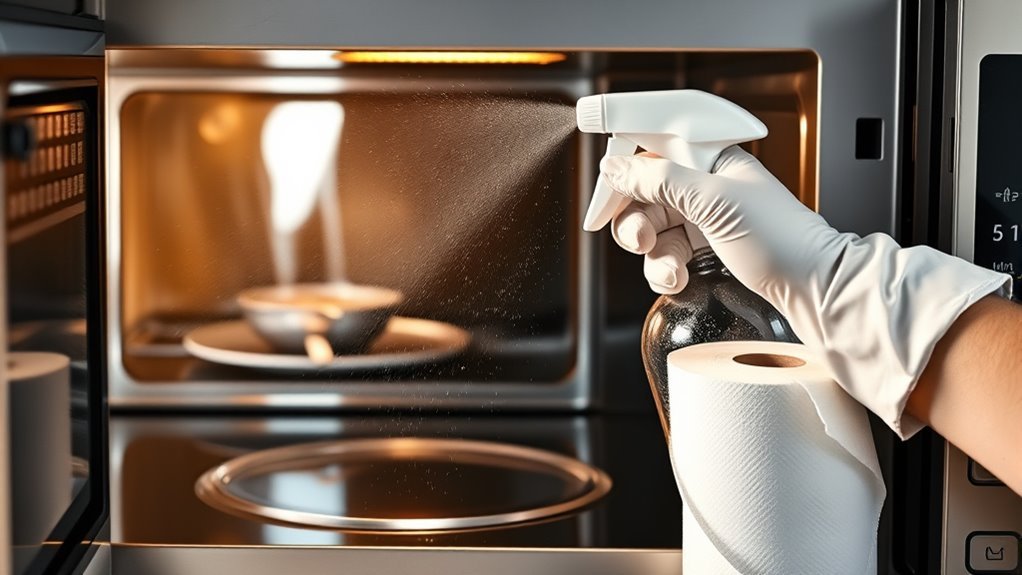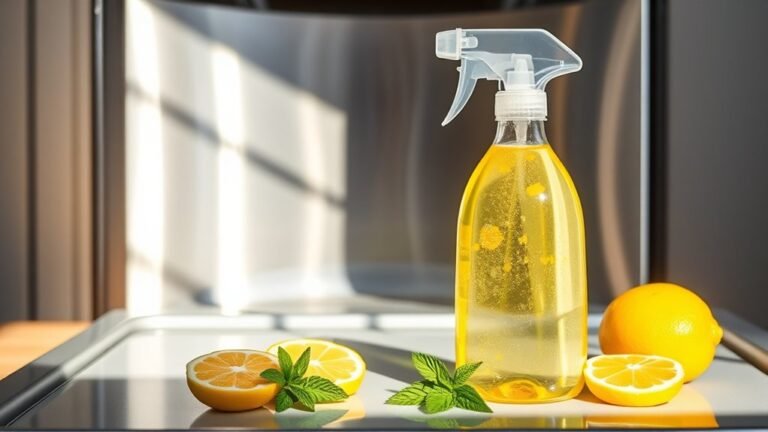Disinfecting High-Touch Areas in Microwave
To disinfect your microwave’s high-touch areas—like the door handle, control panel, and interior seals—start by unplugging it for safety. Use a food-safe disinfectant or a vinegar-water solution applied to a soft cloth, not sprayed directly, to avoid damage. Wipe these spots thoroughly, allowing the disinfectant enough contact time to kill bacteria. Regular cleaning after use helps prevent buildup. If you want to keep your microwave hygienic and safe longer, there are important maintenance and safety steps you should know about.
Identifying High-Touch Areas in Your Microwave

When you’re looking to disinfect your microwave effectively, the first step is to identify the high-touch areas that accumulate the most germs. Focus on the microwave door, especially the handle and edges, since you frequently open and close it, transferring bacteria from your hands. Next, examine the control panel, where you press buttons multiple times daily—this surface often harbors germs due to constant contact. Don’t overlook the interior door frame and seals, as spills and food particles can also contribute to microbial buildup. By pinpointing these critical zones, you’ll concentrate your cleaning efforts where they matter most, ensuring your microwave stays hygienic without wasting time or resources. This targeted approach grants you the freedom to maintain a safe cooking environment efficiently.
Choosing the Right Disinfectants for Microwave Surfaces
Although many disinfectants are available, not all are suitable for microwave surfaces due to heat sensitivity and material compatibility. You’ll want to pick either natural disinfectants or chemical disinfectants that won’t damage your microwave’s interior or leave harmful residues. Here’s a quick guide:
| Disinfectant Type | Pros | Cons |
|---|---|---|
| Natural Disinfectants | Non-toxic, eco-friendly | May require longer contact time |
| Chemical Disinfectants | Fast-acting, strong antimicrobial | Can be harsh on surfaces |
| Alcohol-based | Evaporates quickly, effective | Flammable, use with caution |
Choose products labeled safe for appliances. Always test on a small area first. This guarantees you keep your microwave clean without sacrificing its lifespan or your safety.
Step-by-Step Guide to Cleaning and Disinfecting

Cleaning and disinfecting your microwave effectively involves a few essential steps that target both visible grime and hidden bacteria. First, unplug the microwave and remove the turntable and any detachable parts. Wipe these components with warm, soapy water, then rinse and dry. Next, choose an appropriate disinfectant type—either a food-safe spray or a vinegar-water solution—to avoid damage. Spray the interior surfaces generously, focusing on high-touch areas like the door handle and control panel. Let it sit for the recommended contact time to maximize germ elimination. Wipe down thoroughly with a clean cloth or sponge. For ideal hygiene, maintain a regular cleaning frequency, ideally once a week or after spills. This routine guarantees your microwave stays safe and ready for use without sacrificing your freedom to cook swiftly.
Tips for Maintaining a Germ-Free Microwave
To keep your microwave consistently germ-free, you’ll want to adopt simple daily habits alongside regular deep cleaning. Prioritize microwave hygiene by wiping down the interior and exterior after each use to prevent residue buildup, which harbors germs. Use a damp cloth with mild detergent for surfaces, then disinfect with an appropriate solution. Focus on germ prevention by avoiding metal utensils that scratch surfaces, creating crevices for bacteria.
| Habit | Reason |
|---|---|
| Wipe spills immediately | Stops germ accumulation |
| Use microwave-safe covers | Prevents splatters |
| Clean door handle daily | High-touch area, germ hotspot |
| Schedule weekly deep clean | Guarantees thorough disinfection |
Following these steps helps you maintain a germ-free microwave, enhancing safety and freedom in your kitchen routine.
Safety Precautions When Disinfecting Your Microwave

When disinfecting your microwave, you’ll need to take specific safety precautions to protect yourself and your appliance. First, always wear protective gear such as gloves to avoid skin irritation from cleaning agents. Verify the microwave is unplugged before you start to prevent electrical hazards. Avoid using abrasive materials inside, which can damage the microwave’s interior and compromise microwave safety. Use gentle, non-toxic disinfectants suitable for kitchen appliances. Never spray cleaners directly inside; instead, apply them to a cloth to control moisture and prevent damage to electronic components. After cleaning, ventilate the microwave by running it empty for a minute, verifying no chemical residues remain. Following these steps guarantees effective disinfection while preserving your microwave’s functionality and your personal safety.
Frequently Asked Questions
How Often Should I Deep Clean My Microwave to Prevent Germs?
You should set a deep cleaning frequency of about once a month to keep germs at bay effectively. Alongside regular wipe-downs, this routine helps maintain a hygienic microwave environment. For germ prevention tips, focus on cleaning high-touch areas like buttons and handles with disinfectant. Don’t forget to remove food splatters promptly to avoid bacteria buildup. Staying consistent with these steps means you can enjoy your microwave worry-free and germ-free.
Can Microwave Steam Cleaning Replace Chemical Disinfectants?
You might wonder if microwave steam cleaning can fully replace chemical disinfectants. While steam cleaning benefits include loosening grime and killing some bacteria with heat and moisture, it doesn’t guarantee complete germ elimination like chemical disinfectants do. For thorough sanitation, especially on high-touch surfaces, combining both methods is ideal. Use steam cleaning for routine maintenance and chemical disinfectants when you need a deeper, more reliable cleanse.
Are Natural Disinfectants Effective for Microwave Surfaces?
You can definitely use natural cleaners on microwave surfaces, but their surface effectiveness varies. Ingredients like vinegar and lemon have antimicrobial properties, making them good for light cleaning. However, they might not eliminate all bacteria or viruses as thoroughly as chemical disinfectants. For best results, combine natural cleaners with proper wiping techniques, ensuring you cover high-touch areas well. This way, you maintain a safer, fresher microwave without relying solely on harsh chemicals.
How Do I Remove Odors After Disinfecting the Microwave?
To remove odors after disinfecting, start by placing a bowl of white vinegar or baking soda inside your microwave. These natural odor absorbers work well for scent neutralization. Run the microwave on high for a few minutes to help the solution absorb lingering smells. Afterward, leave the door open to air it out fully. This method frees you from persistent odors without harsh chemicals, keeping your microwave fresh and ready to use.
What Are Signs My Microwave Needs Professional Servicing?
Is your microwave whispering warnings? If you notice uneven heating, strange noises, or sparks inside, these are clear repair indicators. Also, if the door doesn’t seal properly or it stops turning, it’s time for microwave maintenance. Ignoring these signs can limit your freedom to cook effortlessly. To keep your independence in the kitchen, schedule professional servicing promptly—this guarantees your microwave stays reliable and safe for everyday use.






